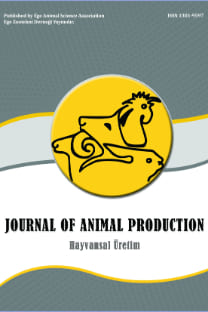Etlik Piliçlerde Kesim Sırasında Uygulanan Soğutma Yöntemlerinin Etin Bazı Kalite Özellikleri ve Raf Ömrü Üzerine Etkisi
Bu
çalışma, kesim işlemleri sırasında piliç karkaslarına uygulanan soğutma
yöntemlerinin piliçlerin göğüs etinde gelişen bazı bakterilerin
sayısına, pH (15 -24), renk
(L*,
a* ve b*) ve su kaybı gibi bazı et kalite özelliklerine olan etkilerini saptamak
amacıyla yürütülmüştür.
Çalışma ticari bir tavuk kesimhanesinde gerçekleştirilmiştir. Piliçler kesimden
önce su soğutma, hava soğutma ve su+hava soğutma olmak üzere üç gruba
ayrılmıştır. Piliç karkaslarına uygulanan soğutma yöntemlerinin, piliçlerin
göğüs eti üzerinde gelişen mikroorganizmalara etkisini belirlemek için her gruptan
alınan 10 (5♂:5♀) piliç göğüs eti örneğinde 0,
3, 5, 7 ve 9. günlerde mezofilik ve psikrofil bakteri sayıları incelenmiştir. Ayrıca,
kesim sonrası göğüs eti kalite özelliklerini değerlendirmek için her soğutma
grubundan 30 (15♂:15♀), toplam 90 piliç karkası
kullanılmıştır.
Araştırma sonuçları, hava ile soğutmanın depolanma sırasında, piliçlerin
göğüs eti üzerinde bakterilerin gelişimini geciktirdiğini (P<0.05) ve
raf ömrünü olumlu yönde etkilediğini ortaya koymuştur. Soğutma yönteminin piliç
etlerinin pH ve renk değeri üzerine etkisi önemli bulunmamıştır (P > 0.05). En fazla su kaybı
hava ile soğutulan piliç etlerinde ortaya çıkmıştır. Ayrıca, incelenen
özellikler üzerine cinsiyet etkisi önemli bulunmamıştır (P >
0.05).
Anahtar Kelimeler:
Soğutma yöntemi, et kalitesi, mikrobiyolojik kalite
___
- Barbut, S. 2002. Primary processing of poultry in Poultry Products Processing: An Industry Guide, 81–107.
- Berrang, M. E., Meinersmann, R. J., Smith, D. P., Zhuang, H. 2008. The effect of chilling in cold air or ice water on the microbiological quality of broiler carcasses and the population of Campylobacter1. Poultry Sci. 87: 992–998.
- Carol, C.D., Alvarado C.Z. 2008. Comparison of air and immersion chilling on meat quality and shelf life of marinated broiler breast fillets. Poultry Sci. 87: 368–372.
- Davies, A., Board, R. 1998 The microbiology of meat ve poultry. Andrew Dawis Ed., Ron Board, 1st edition, London, UK.
- Fleming, B. K., Froning, G. W., Yang, T. S. 1991. Heme pigment levels in chicken broilers chilled in ice slush and air. Poultry Sci. 70: 2197–2200.
- FAO. 1992. Manual of food quality control. 4. Rev. 1. Microbiological Analysis. Food and Agricultural Organization of the United Nations, Rome, 43-56.
- Gallo, L., Schmitt, R. E., Schmitt-Lorenz, W. 1988. Microbial spoilage of refrigerated fresh broilers. I. Bacterial flora and growth during storage. Lebensm.-Wiss. u.-Technol. 21: 216-223.
- Hargis, B. M., Caldwell, D. J., Byrd, J. A. 2001. Microbiological pathogens: Live poultry considerations. Poultry Meat Processing. Sams, A. R. (ed.), CRC Press, USA, pp. 121-137
- Honikel, K. 1997. Reference methods supported by OECD and their use in Mediterranean meat products. Food Chem. 59: 573-582.
- Hinton, A., Cason, J. A., Ingram, K. D. 2004. Tracking spoilage bacteria in commercial poultry processing and refrigerated storage of poultry carcasses. Int. J. Food Microbiol. 91: 155-165.
- Huezo, R., Smith, D. P., Northcutt, J. K., Fletcher, D. L. 2007a. Effect of immersion or dry air chillingon broiler carcass moisture retentionand breast fillet functionality. Poultry Res. 16: 438–447.
- Huezo, R., Smith, D. P., Northcutt, J. K., Fletcher, D. L. 2007b. Effect of chilling method and deboning time on broiler breast filet quality. J. Appl. Poult. Res. 16: 537–545.
- Hunt, M,C., Acton, J.C., Benedict, R, C., Calkins, C.R., Cornforth, D.P., Jeremiah, L,E., Olson, D.P., Salm, C.P., Savell, J.W., Shiwas, S.D. 1991. Guidelines for meat color evaluation. Chicago: American Meat Sci. Assoc. and National Live Stock and Meat Board.
- Janardhanan, K. K. 2011. Evaluation of chilling methods on broiler carcass appearance, texture, sensory and microbial quality. Michigan State University. Master tezi. U.S.A.
- Jeong, J. Y., Janardhanan, K. K, Booren, A. M,. Karcher, D. M, Kang, I. 2011. Moisture content, processing yield, and surface color of broiler carcasses chilled by water, air, or evaporative air. Poultry Sci. 90: 687–693.
- McKee, S. 2001. Chilling of broiler immersion and air. Watt Poultry Sci. 12: 18-24.
- Mielnik, M. B., Dainty, R. H, Lundby, F., Mielnik, J. 1999. The effect of evaporative air chilling and storage temperature on quality and shelf life of fresh chicken carcasses. Poultry Sci. 78: 1065–1073
- Northcutt, J. K., Cason, J. A., Smith, D. P., Buhr, R. J., Fletcher, D. L. 2006. Broiler carcass bacterial counts after immersion chilling using either a low or high volume of water. Poultry Sci. 85: 1802–1806.
- Regez, P., Gallo, L., Schmitt, R.E., Schmitt Lorenz, W. 1988. Microbial spoilage of refrigerated fresh broilers. III. Effect of storage temperature on the microbial association of poultry carcasses. Lebensm.-Wiss. u.-Technol. 21: 229-233.
- Sanchez, M. X., Fluckey, W. M., Brashears, M. M., McKee, S. R. 2002. Microbial profile and antibiotic susceptibility of Campylobacter spp. and Salmonella spp. in broilers processed in air-chilled and immersion-chilled environments. J. Food Prot. 65: 948–956.
- SPSS, 2011. SPSS for Windows, Release 19.0, SPSS Inc.
- Swanson, K., Busta, F.F., Peterson, E. H., Johnson., M. G. 1992. Colony counts method. Public health association. chapter 16: 239-249. Washington, D.C
- Tuncer, B., Sireli, U. T. 2008. Microbial growth on broiler carcasses stored at different temperatures after air or water-chilling. Poultry Sci. 87: 793–799.
- Veerkamp, C. H. 1990. Chilling of poultry and poultry products. 8 in Chilled Foods: The State of Art. T. R.Gormley, ed. Elsevier Appl. Sci. S. 147–15, New York.
- Zhuang, H., Savage, E.M , Smith, D.P, Berrang, M.E. 2008. Effect of dry-air chilling on warner-bratzler shear force and water-holding capacity of broiler breast meat deboned four hours postmortem. International Journal of Poultry Sci. 7(8): 743-748.
- Zhuang, H., Savage, E.M. 2009. Variation and pearson correlation coefficients of warner-bratzler shear force measurements within broiler breast fillets. Poult. Sci. 88: 214–220.
- ISSN: 1301-9597
- Başlangıç: 1974
- Yayıncı: EGE ZOOTEKNİ DERNEĞİ
Sayıdaki Diğer Makaleler
Farklı Gelişme Dönemlerinde Hasat Edilmiş Tritikale Hasılında Morfolojik Unsurların Besin Değeri
Memeli Çiftlik Hayvanlarında Stres, Fizyoloji ve Üretim İlişkileri
Keçilerde Kazeöz Lenfadenitis (KLA) Hastalığına Bağlı Yüzlek Apse Sıklığının Değişimi
Kuluçkada Yumurta İçi (In Ovo) Besleme Uygulamaları
Süt Sığırlarında Mevsimsel Beslemenin Sütün Karotenoid İçeriğine Etkileri
Hayrettin ÇAYIROĞLU, Güray ERENER, Ahmet ŞAHİN
Süt Sığırcılığında Yapay Zeka Teknolojisi: Bulanık Mantık ve Yapay Sinir Ağları
